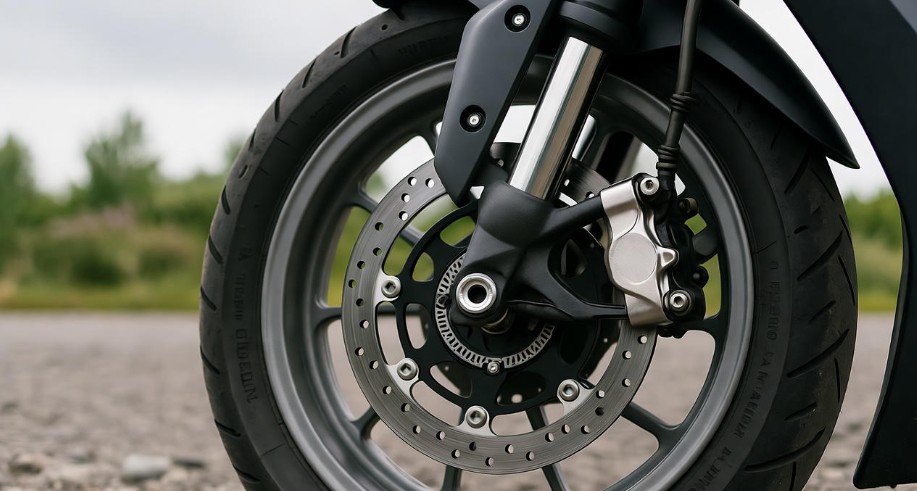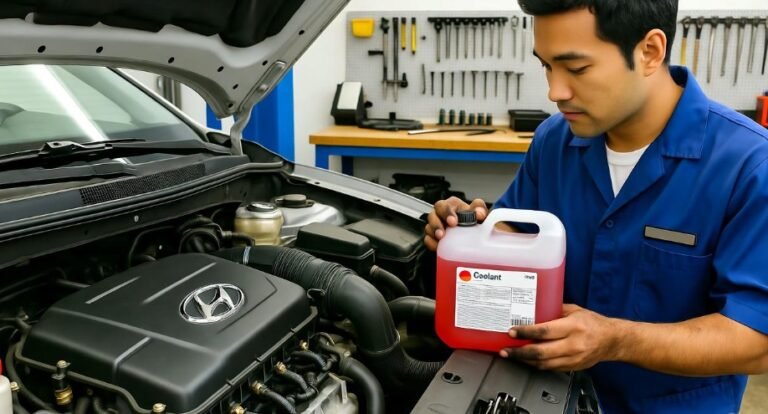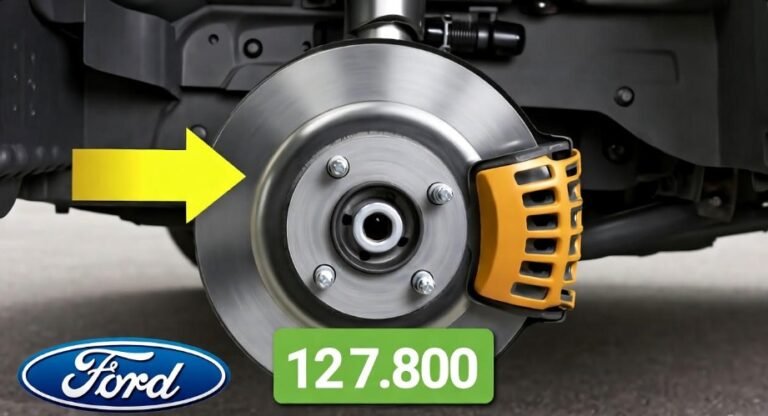Pulsar 220f Rear Disc Brake Caliper Price

The Pulsar 220f rear disc brake caliper price can range from around $30 to $80 for a new unit, depending on the brand and seller. Genuine Bajaj parts may be slightly higher. DIY replacement saves labor costs, while professional installation adds to the overall expense.
In This Article
- 1 Key Takeaways
- 2 Understanding Your Pulsar 220f’s Rear Disc Brake Caliper
- 3 Factors Influencing Pulsar 220f Rear Disc Brake Caliper Price
- 4 Estimated Price Range for Pulsar 220f Rear Disc Brake Caliper
- 5 Cost of Installation: DIY vs. Professional
- 6 Maintaining Your Brake Caliper to Avoid Frequent Replacements
- 7 Common Issues with Pulsar 220f Rear Disc Brake Calipers
- 8 Troubleshooting Your Rear Brake Performance
- 9 FAQ: Pulsar 220f Rear Disc Brake Caliper Price and More
- 9.1 Q1: What is the typical lifespan of a Pulsar 220f rear brake caliper?
- 9.2 Q2: Can I use a universal brake caliper for my Pulsar 220f?
- 9.3 Q3: Where can I find the cheapest Pulsar 220f rear disc brake caliper price?
- 9.4 Q4: What are the symptoms of a failing rear brake caliper?
- 9.5 Q5: Is it cheaper to rebuild a caliper or buy a new one?
- 9.6 Q6: How do I know if I need to replace the brake caliper or just the brake pads?
- 9.7 Q7: Does the Pulsar 220f rear disc brake caliper price include brake fluid?
- 10 Conclusion
Key Takeaways
- Understand rear caliper price factors.
- Find accurate Pulsar 220f caliper costs.
- Compare genuine vs. aftermarket part prices.
- Factor in installation costs if not DIY.
- Identify reliable sources for brake parts.
- Learn about caliper maintenance to extend life.
Your Bajaj Pulsar 220f is a powerhouse on two wheels, known for its performance and style. When it comes to maintaining its stopping power, the rear disc brake caliper is a critical component. You might be wondering about the Pulsar 220f rear disc brake caliper price if yours needs a replacement or if you’re planning preventative maintenance. Understanding these costs is key to keeping your ride safe and performing at its best. This guide will break down everything you need to know about the price, where to find it, and what influences it, ensuring you make informed decisions for your motorcycle.
Understanding Your Pulsar 220f’s Rear Disc Brake Caliper
The brake caliper is a vital part of your motorcycle’s braking system. It’s the component that houses the brake pads and, when you apply the rear brake lever, it squeezes those pads against the brake disc (rotor). This friction is what slows down or stops your Pulsar 220f. A fully functional caliper ensures even pressure distribution for optimal braking performance and rider safety.
If you notice symptoms like a spongy brake lever, reduced braking effectiveness, grinding noises, or leaks around the rear wheel, your brake caliper might be the culprit. These issues can stem from worn-out seals, seized pistons, or general wear and tear. Addressing these problems promptly is crucial, as brake system failures can have serious consequences.
Factors Influencing Pulsar 220f Rear Disc Brake Caliper Price
Several factors can affect the price you’ll pay for a Pulsar 220f rear disc brake caliper. Understanding these will help you budget effectively. Here are the primary considerations:
- Brand and Quality: This is often the biggest price driver.
- Genuine vs. Aftermarket: Original Equipment Manufacturer (OEM) parts versus third-party options.
- Seller and Location: Where you buy your caliper from matters.
- Included Components: Does the caliper come with mounting hardware or brake pads?
- Condition: New versus remanufactured or used parts.
Genuine Bajaj vs. Aftermarket Calipers
When it comes to motorcycle parts, you’ll often encounter two main categories: genuine and aftermarket. For your Pulsar 220f, this distinction is important for both price and performance.
Genuine Bajaj Parts
Genuine Bajaj parts are manufactured by or for Bajaj Auto. They are designed to meet the exact specifications of your Pulsar 220f. The primary advantage of genuine parts is their guaranteed fit and quality, ensuring they perform as intended by the manufacturer. However, this quality assurance often comes with a higher price tag.
You can expect genuine Pulsar 220f rear disc brake calipers to be on the higher end of the price spectrum. They offer peace of mind that you are installing a component that is precisely engineered for your motorcycle.
Aftermarket Calipers
Aftermarket parts are made by companies other than the original manufacturer. The market for aftermarket motorcycle parts is vast, offering a range of options from budget-friendly to high-performance. For a rear disc brake caliper, aftermarket options can be significantly cheaper than genuine ones.
The quality of aftermarket parts can vary widely. Some are made to equivalent or even superior standards as genuine parts, while others might compromise on materials or manufacturing processes to achieve a lower cost. It’s crucial to research reputable aftermarket brands for your Pulsar 220f to ensure you’re getting good value and reliability.
Where to Buy Your Pulsar 220f Rear Disc Brake Caliper
The Pulsar 220f rear disc brake caliper price can differ depending on where you make your purchase. Online retailers, local motorcycle shops, and specialized parts dealers all offer different pricing and selections.
Online Retailers: Websites like Amazon, eBay, and dedicated motorcycle parts online stores often have a wide selection of both genuine and aftermarket calipers. Prices can be competitive due to lower overhead. However, you lose the ability to physically inspect the part before buying and might have shipping costs to consider.
Local Motorcycle Dealerships/Shops: Your nearest Bajaj dealership or a reputable independent motorcycle shop is a reliable source for genuine parts. They can also help identify the correct part for your specific Pulsar 220f model and year. While they may not always have the lowest prices, you get expert advice and support.
Specialized Parts Websites: There are numerous websites that specialize in motorcycle parts for specific brands or models. These can be excellent places to find a good balance of price, quality, and selection, especially for aftermarket components.
Estimated Price Range for Pulsar 220f Rear Disc Brake Caliper
Let’s get down to the numbers. The Pulsar 220f rear disc brake caliper price can fluctuate, but here’s a general breakdown based on typical market rates observed across various sources in the USA:
| Part Type | Estimated Price Range (USD) | Notes |
|---|---|---|
| Genuine Bajaj Caliper (New) | $50 – $80+ | Includes OEM specifications, highest reliability. |
| Reputable Aftermarket Caliper (New) | $30 – $60 | Good quality, offers value for money. |
| Budget Aftermarket Caliper (New) | $25 – $45 | May have shorter lifespan or variable quality. |
| Remanufactured/Used Caliper | $20 – $40 | Inspect carefully for wear and functionality. |
It’s important to remember that these are estimates. Prices can vary based on the seller’s markup, current market demand, and any ongoing sales or promotions. Always check multiple sources to find the best deal.
Cost of Installation: DIY vs. Professional
The Pulsar 220f rear disc brake caliper price is only one part of the total cost of replacement. The labor involved in installation is another significant factor, especially if you’re not performing the work yourself.
Do-It-Yourself (DIY) Replacement
If you’re handy with tools and have some mechanical experience, replacing your Pulsar 220f’s rear brake caliper can be a cost-saving endeavor. The main costs involved would be purchasing the caliper itself and potentially some basic tools if you don’t already have them (like wrenches, a brake fluid bleeder kit, and brake cleaner).
Tools you might need:
- Socket wrench set
- Wrench set
- Torque wrench (highly recommended for proper reassembly)
- Brake fluid (DOT 3 or DOT 4, check your manual)
- Brake cleaner
- Gloves and eye protection
- Brake bleeding kit (optional but helpful)
- Pliers
The DIY route can save you anywhere from $50 to $150 or more in labor costs, depending on what a professional shop would charge. However, it requires time, patience, and the correct technique to ensure the braking system is properly bled and functioning safely. Improper installation can lead to brake failure.
Professional Installation Costs
If you prefer to have a qualified mechanic handle the replacement, you’ll need to factor in their labor rates. Motorcycle mechanics typically charge anywhere from $60 to $120 per hour. Replacing a brake caliper is usually a straightforward job, often taking about 1 to 2 hours.
Factors influencing professional installation costs:
- Shop labor rates (vary by region and shop type)
- Complexity of the job (sometimes other parts might need to be removed)
- Whether the shop supplies the part or you bring your own
Always get a quote from the shop before authorizing work. If you’re buying the part from the shop, they may offer a package deal or warranty on both the part and the labor.
Maintaining Your Brake Caliper to Avoid Frequent Replacements
Understanding the Pulsar 220f rear disc brake caliper price is one thing, but extending the life of your current caliper can save you money in the long run. Regular maintenance is key to preventing premature wear and ensuring optimal performance.
Regular Cleaning
Dirt, dust, and road debris can accumulate around the caliper, leading to corrosion and hindering the movement of the caliper pistons. Periodically cleaning the caliper with a dedicated brake cleaner and a brush can help keep it in good working order.
Checking Brake Fluid
The brake fluid is the hydraulic medium that transmits force from the lever to the caliper. Ensure your brake fluid reservoir is at the correct level and that the fluid itself is clean. Old, contaminated fluid can lead to corrosion within the brake system. Many manufacturers recommend flushing and replacing brake fluid every one to two years. You can find guidance on brake fluid types and maintenance on the U.S. Department of Transportation’s National Highway Traffic Safety Administration (NHTSA) website, which offers safety standards and recalls.
Visit the NHTSA website for more on vehicle safety and maintenance.
Inspecting Brake Pads and Rotors
Worn-out brake pads can damage the caliper’s pistons and bore. Regularly inspect your brake pads for thickness. If they are low, replace them promptly. Also, check the brake rotor for scoring, warping, or excessive wear. A damaged rotor can also put undue stress on the caliper.
Lubricating Caliper Pins
The caliper slides on pins to allow it to move freely and apply even pressure. These pins can seize if not properly lubricated. When you replace brake pads, it’s a good time to clean and re-lubricate these pins with high-temperature brake lubricant. This ensures smooth operation and prevents uneven pad wear.
Pro Tip: When bleeding your brakes, ensure you use the correct type of brake fluid specified in your Pulsar 220f owner’s manual to avoid damaging seals.
Common Issues with Pulsar 220f Rear Disc Brake Calipers
Even with good maintenance, brake calipers can develop problems. Knowing these common issues can help you identify potential issues early.
Seized Caliper Pistons
This is a frequent problem where one or more pistons within the caliper become stuck due to corrosion or dirt buildup. A seized piston means that side of the brake pad won’t apply pressure to the rotor, leading to uneven braking, or it might stick, causing the brake to drag constantly, leading to overheating and rapid pad wear.
Leaking Brake Fluid
The seals around the caliper pistons can degrade over time, leading to leaks. You might notice fluid on the caliper body or weeping from around the piston. Leaking fluid reduces hydraulic pressure and is a critical safety concern.
Worn Caliper Bore
The inside of the caliper where the pistons move can become scored or worn, especially if dirt has entered the system or if brake pads have been run to failure. This wear can cause fluid leaks and prevent the pistons from sealing properly, leading to a spongy brake lever.
Corrosion
Exposure to water, salt (if you ride in winter conditions or near coastal areas), and road grime can cause the caliper body itself to corrode, especially if it’s made of aluminum. This can affect the seals and the smooth operation of the pistons.
Troubleshooting Your Rear Brake Performance
If you’re experiencing issues with your Pulsar 220f’s rear brake, here’s a simple troubleshooting guide. Remember, brake system issues are safety critical, so if you’re unsure, consult a professional.
- Check Brake Fluid Level: Ensure the fluid in the reservoir is between the MIN and MAX lines. If low, top it up with the correct DOT fluid and check for leaks.
- Inspect Brake Pads: Remove the caliper and visually inspect the brake pads. Are they worn down to the metal backing plate? Are they unevenly worn?
- Examine Rotor: Look at the brake rotor. Is it heavily grooved, scored, or warped? Any discoloration could indicate overheating.
- Check Caliper Movement: With the pads removed, try to push the caliper pistons back into their bores. If they are stiff or won’t retract, the caliper may be seized.
- Inspect for Leaks: Look for any signs of brake fluid leakage around the caliper body, brake line, or bleed screw.
If you find any of these issues, it’s likely time to consider a caliper replacement or a rebuild kit if the bore is salvageable.
FAQ: Pulsar 220f Rear Disc Brake Caliper Price and More
Here are some frequently asked questions about the Pulsar 220f rear disc brake caliper price and related topics:
Q1: What is the typical lifespan of a Pulsar 220f rear brake caliper?
A: The lifespan of a brake caliper can vary greatly depending on riding conditions, maintenance, and the quality of the part. Generally, a caliper can last anywhere from 30,000 to 60,000 miles or more, but it’s essential to inspect it regularly for any signs of wear or malfunction.
Q2: Can I use a universal brake caliper for my Pulsar 220f?
A: While some “universal” parts exist, it is highly recommended to use a caliper specifically designed for the Bajaj Pulsar 220f. A proper fit ensures correct mounting, piston size, and fluid line connection, which are critical for safe and effective braking.
Q3: Where can I find the cheapest Pulsar 220f rear disc brake caliper price?
A: You’ll often find the cheapest prices on large online marketplaces like eBay or Amazon, especially for aftermarket options. However, always prioritize reputable sellers and check reviews to ensure quality. Local dealers might offer competitive pricing during sales events.
Q4: What are the symptoms of a failing rear brake caliper?
A: Symptoms include a spongy or soft brake lever, reduced braking power, grinding noises when braking, a persistent drag on the rear wheel, and visible fluid leaks around the caliper or brake line.
Q5: Is it cheaper to rebuild a caliper or buy a new one?
A: The cost-effectiveness of rebuilding versus buying new depends on the damage. If the caliper bore is heavily scored or corroded, a rebuild kit might not be sufficient, making a new caliper (especially an aftermarket one) a better investment long-term. Simple seal replacement might make a rebuild cheaper.
Q6: How do I know if I need to replace the brake caliper or just the brake pads?
A: If your brake pads are worn but the caliper pistons move freely and there are no leaks or significant corrosion, you likely only need to replace the pads. If the pistons are seized, leaking, or the caliper bore is damaged, replacement is usually necessary.
Q7: Does the Pulsar 220f rear disc brake caliper price include brake fluid?
A: Generally, no. The price of the caliper typically covers the caliper unit itself. You will need to purchase brake fluid separately for flushing and bleeding the system after installation.
Conclusion
The Pulsar 220f rear disc brake caliper is a crucial safety component that requires attention. Understanding the Pulsar 220f rear disc brake caliper price, which can range from about $30 to $80 or more, empowers you to budget effectively for maintenance or replacement. Whether you opt for a genuine Bajaj part or a reliable aftermarket option, always consider the quality and seller. Remember to factor in installation costs if you aren’t performing the work yourself. By performing regular maintenance and being aware of common issues, you can extend the life of your existing caliper and ensure your Pulsar 220f remains a safe and enjoyable ride.






